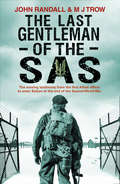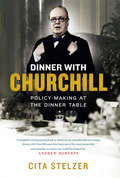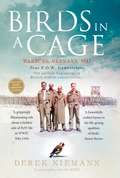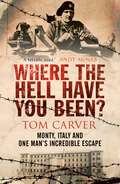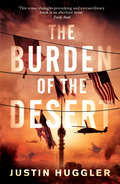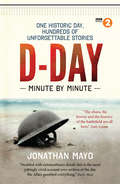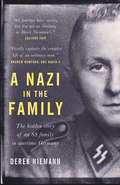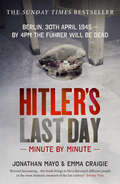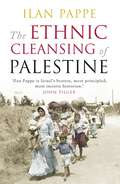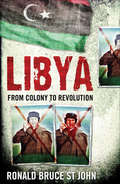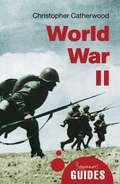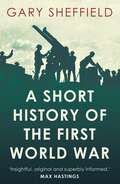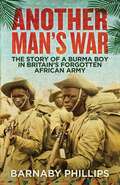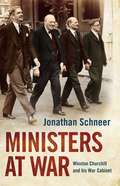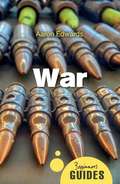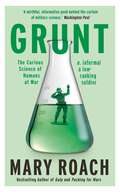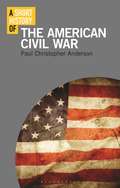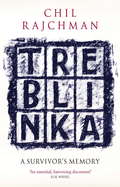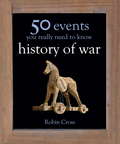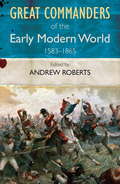- Table View
- List View
The Last Gentleman of the SAS: A Moving Testimony from the First Allied Officer to Enter Belsen at the End of the Second World War
by John Randall M J TrowIn 1945, John Randall was the first Allied officer to enter Bergen-Belsen – the concentration camp that would reveal the horrors of the Holocaust to the world. Randall was one of that league of extraordinary gentlemen handpicked for suicidally dangerous missions behind enemy lines in North Africa, Italy, France and Germany throughout the Second World War. He was a man of his class and of his times. He hated the Germans, liked the French and was unimpressed by the Americans and the Arabs. He was an outrageous flirt, as might be expected of a man who served in Phantom alongside film stars David Niven and Hugh Williams. He played rugby with Paddy Mayne, the larger-than-life colonel of the SAS and winner of four DSOs. He pushed Randolph Churchill, son of the Prime Minister, out of an aeroplane. He wined and dined in nightclubs as part of the generation that lived for each day because they might not see another.This extraordinary true story, partly based on previously unpublished diaries, presents a different slant on that mighty war through the eyes of a restless young man eager for action and adventure.
Dinner with Churchill: Policy-Making at the Dinner Table
by Cita Stelzer"A delightful and delicious tribute to Churchill's heroic appetite for wining, dining and politicking" - Ben Macintyre, author of Operation Mincemeat. A friend once said of Churchill "He is a man of simple tastes; he is quite easily satisfied with the best of everything." But dinners for Churchill were about more than good food, excellent champagnes and Havana cigars. "Everything" included the opportunity to use the dinner table both as a stage on which to display his brilliant conversational talents, and an intimate setting in which to glean gossip and diplomatic insights, and to argue for the many policies he espoused over a long life. In this riveting, informative and entertaining book Cita Stelzer draws on previously untapped archival material, diaries of guests, and a wide variety of other sources to tell of some of the key dinners at which Churchill presided before, during and after World War II - including the important conferences at which he used his considerable skills to attempt to persuade his allies, Franklin Roosevelt and Joseph Stalin, to fight the war according to his strategic vision. With fascinating new insights into the food he ate, the champagnes he loved, as well as original menus, seating plans and unpublished photographs, Dinner with Churchill is a sumptuous treat. The next best thing to being there yourself.
Dinner with Churchill: Policy-Making at the Dinner Table
by Cita Stelzer"A delightful and delicious tribute to Churchill's heroic appetite for wining, dining and politicking" - Ben Macintyre, author of Operation Mincemeat. A friend once said of Churchill "He is a man of simple tastes; he is quite easily satisfied with the best of everything." But dinners for Churchill were about more than good food, excellent champagnes and Havana cigars. "Everything" included the opportunity to use the dinner table both as a stage on which to display his brilliant conversational talents, and an intimate setting in which to glean gossip and diplomatic insights, and to argue for the many policies he espoused over a long life. In this riveting, informative and entertaining book Cita Stelzer draws on previously untapped archival material, diaries of guests, and a wide variety of other sources to tell of some of the key dinners at which Churchill presided before, during and after World War II - including the important conferences at which he used his considerable skills to attempt to persuade his allies, Franklin Roosevelt and Joseph Stalin, to fight the war according to his strategic vision. With fascinating new insights into the food he ate, the champagnes he loved, as well as original menus, seating plans and unpublished photographs, Dinner with Churchill is a sumptuous treat. The next best thing to being there yourself.
Birds in a Cage: Warburg, Germany, 1941- Four P. O. W. Birdwatchers - The Unlikely Beginning Of British Wildlife Conservation...
by Derek NiemannThis is the inspiring true story of how a passion for birds enabled four young men to escape the horror of internment in a German PoW camp... and brought about an extraordinary moment of cooperation and mutual understanding between them and their captors. Soon after their incarceration at Warburg in 1941, Peter Conder, John Buxton, John Barrett and George Waterston discovered a shared love of birdwatching. Before long, their obsessive quest for information on the nesting habits of chaffinches, redstarts and others took over the whole camp - including some of the German guards, who began to assist the PoWs in their observations at great risk to their own lives. In this tender, revelatory book, Derek Niemann draws on original diaries, letters and drawings, as well as the memories of those...
Where The Hell Have You Been?: Monty, Italy and One Man's Incredible Escape
by Tom CarverIn November 1942 a young British army officer was captured. This gripping story tells of Richard"s internment in a POW camp in northern Italy and of his subsequent escape.
Where The Hell Have You Been?: Monty, Italy and One Man's Incredible Escape
by Tom CarverIn November 1942 a young British army officer was captured. This gripping story tells of Richard"s internment in a POW camp in northern Italy and of his subsequent escape.
Burden of the Desert
by Justin HugglerThe Burden of the Desert is fast-paced and gripping, and asks questions that will linger long after the last page is turned. Via the lives of a fascinating group of characters, former war correspondent Justin Huggler memorably evokes the atmosphere of a military occupation whose aftershocks are still being felt today.
Burden of the Desert
by Justin HugglerThe Burden of the Desert is fast-paced and gripping, and asks questions that will linger long after the last page is turned. Via the lives of a fascinating group of characters, former war correspondent Justin Huggler memorably evokes the atmosphere of a military occupation whose aftershocks are still being felt today.
D-Day Minute By Minute: One historic day, hundreds of unforgettable stories (Minute By Minute)
by Jonathan MayoThe invasion has begun. In this gripping book, Jonathan Mayo gives a blow by blow account of the events of D-Day, revealing what happened to the people swept up in this crucial moment in history. From soldiers, French villagers and journalists, to schoolchildren and nurses, thousands were placed in extraordinary situations when the Allies landed in Normandy. This is their story.
A Nazi in the Family: The hidden story of an SS family in wartime Germany
by Derek NiemannWARTIME BERLIN: The Niemann family - Karl, Minna and their four children - live in a quiet, suburban enclave. Every day Karl commutes to work, a business manager travelling around inspecting his “factories”. In the evenings he returns home to life as a normal family man.Three years ago Derek Niemann, born and raised in Scotland, made the chilling discovery that his grandfather Karl had been an officer in the SS - and that his “business” used thousands of slave labourers in concentration camps, such as Auschwitz, Dachau, Buchenwald and Sachsenhausen. Derek had known little about the German side of his family, but now a lifetime of unsettling hints and clues began to fall into place.With the help of surviving relatives and hundreds of previously unknown family photographs, Derek uncovers the true story of what Karl did. A Nazi in the Family is an illuminating portrayal of how ordinary people can fall into the service of a monstrous regime.
Hitler's Last Day: The Hidden Story Of An Ss Family In Wartime Germany (Minute By Minute Ser.)
by Jonathan Mayo Emma CraigieOn 30th April 1945 Germany is in chaos...Russian troops have reached Berlin. All over the country, people are on the move - concentration camp survivors, Allied PoWs, escaping Nazis - and the civilian population is fast running out of food. The man who orchestrated this nightmare is in his bunker beneath the capital, saying his farewells.This is the gripping story of Hitler's final hours, as seen through the eyes of those who were with him in the bunker; those fighting in the streets of Germany; and those pacing the corridors of power in Washington, London and Moscow.30th April 1945 was a day that millions had dreamed of, and millions had died for.
The Ethnic Cleansing of Palestine
by Ilan PappeThe book that is providing a storm of controversy, from &‘Israel&’s bravest historian&’ (John Pilger)Renowned Israeli historian, Ilan Pappe's groundbreaking work on the formation of the State of Israel. 'Along with the late Edward Said, Ilan Pappe is the most eloquent writer of Palestinian history.' NEW STATESMAN Between 1947 and 1949, over 400 Palestinian villages were deliberately destroyed, civilians were massacred and around a million men, women, and children were expelled from their homes at gunpoint. Denied for almost six decades, had it happened today it could only have been called 'ethnic cleansing'. Decisively debunking the myth that the Palestinian population left of their own accord in the course of this war, Ilan Pappe offers impressive archival evidence to demonstrate that, from its very inception, a central plank in Israel&’s founding ideology was the forcible removal of the indigenous population. Indispensable for anyone interested in the current crisis in the Middle East. *** 'Ilan Pappe is Israel's bravest, most principled, most incisive historian.' JOHN PILGER 'Pappe has opened up an important new line of inquiry into the vast and fateful subject of the Palestinian refugees. His book is rewarding in other ways. It has at times an elegiac, even sentimental, character, recalling the lost, obliterated life of the Palestinian Arabs and imagining or regretting what Pappe believes could have been a better land of Palestine.' TIMES LITERARY SUPPLEMENT 'A major intervention in an argument that will, and must, continue. There's no hope of lasting Middle East peace while the ghosts of 1948 still walk.' INDEPENDENT
Libya
by Ronald Bruce St. JohnCombining a historian's balance with an analyst's insight to skilfully navigate Libya's eventful past and present, Ronald Bruce St John updates his authoritative history of this turbulent North African state to include an in-depth examination of the 2011 rebellion that finally put an end to over 40 years of authoritarian rule by Qadaffi. From early Greek settlements to the infamous Lockerbie bombing, and from the colonel's astonishing return to the international stage to the events that led to his ousting, this stands as an essential introduction to this complex land on the cusp of Africa and the Middle East. Ronald Bruce St John is a scholar of Libya, having consulted to ABC's 20/20, the New York Times, Fortune 500 companies, and the U.S. government. Now an analyst for the progressive think tank Institute for Policy Studies, he has also served on the advisory board of The Journal of Libyan Studies and the Atlantic Council's working group on Libya. A former military intelligence officer in the US army, he is the author of Libya and the United States and Qaddafi's World Design, among other books.
World War II: A Beginner's Guide (Beginner's Guides)
by Christopher CatherwoodWith over sixty million casualties, World War II was the bloodiest conflict in history. In this incisive introduction, esteemed academic Christopher Catherwood covers all the key battles and campaigns, while also giving the larger story behind them, putting familiar events into the perspective of the war at large. He explores the huge impact of the preceding Sino-Japanese War on World War II itself; the relative unimportance of the British conflict in Africa; the near moral-equivalence of the Red Army and the Nazis; and the impact of the Hiroshima bombing. Full of text-boxes revealing key details about British intelligence, weaponry, and the social milieu to the conflict, there is no better brief introduction to this landmark event.
A Short History of the First World War (Short Histories Ser.)
by Gary SheffieldSynthesizing the latest scholarship, acclaimed military historian Gary Sheffield cuts to the heart of the conflict that involved every major economic power in the world. With an emphasis on the Western Front, Sheffield explores such key issues as the causes of war; the search for peace and the peace settlements; the political, social, and economic consequences; the impact of "total war" on the war efforts of the belligerents; and the place of the War in the history of warfare. Accessible and incisive, this is the ultimate introduction for anyone wanting a clear understanding of what happened and why.
Another Man's War: The Story Of A Burma Boy In Britain's Forgotten Army
by Barnaby PhillipsIn December 1941 the Japanese invaded Burma. For the British, the longest land campaign of the Second World War had begun. 100,000 African soldiers were taken from Britain’s colonies to fight the Japanese in the Burmese jungles. They performed heroically in one of the most brutal theatres of war, yet their contribution has been largely ignored. Isaac Fadoyebo was one of those 'Burma Boys’. At the age of sixteen he ran away from his Nigerian village to join the British Army. Sent to Burma, he was attacked and left for dead in the jungle by the Japanese. Sheltered by courageous local rice farmers, Isaac spent nine months in hiding before his eventual rescue. He returned to Nigeria a hero, but his story was soon forgotten. Barnaby Phillips travelled to Nigeria and Burma in search of Isaac, the family who saved his life, and the legacy of an Empire. Another Man’s War is Isaac’s story.
Ministers at War: Winston Churchill and his War Cabinet
by Jonathan SchneerBritain's wartime cabinet brought together Conseratives, Labour and independent in a coalition of political titans, including Bevan, Atlee, Beverbrook, Morrison, Eden and Cripps. This is the gripping story of how they governed and won. Under Churchill's leadership they overcame political and personal differences in service of the national interest in a time of great crisis.But behind closed doors there were rivalries and intrigues, as well as unexpected friendships - brought to life here through Jonathan Schneer's original research and vivid writing. With fascinating portraits of the figures involved and sharp analysis of the political ups and downs, Ministers at War is a unique and essential perspective on World War II.
War: A Beginner's Guide (Beginner's Guides)
by Aaron EdwardsWar has been a perennial feature of human history since ancient times, yet it remains a poorly understood phenomenon. It has done much to shape our world, from overthrowing leaders, establishing international governance, and inspiring social change, to destroying cities, dividing nations and breeding animosity.In this book, Dr Aaron Edwards succinctly combines political theories with historical realities. Using eyewitness accounts, war poetry and insightful analysis of a wide range of conflicts, War: A Beginner's Guide introduces the reader to the complexity and human face of war and invites readers to question whether violence is the most effective way to resolve disputes.
Grunt: The Curious Science of Humans at War
by Mary RoachA finalist for the Los Angeles Times Science & Technology Book Prize &‘The most entertaining writer in science&’ – The Times, Books of the Year War. Mention it and most of us think of history, of conflicts on foreign soil, of heroism and compromise, of strategy and weapons. But there&’s a whole other side to the gruesome business of the battlefield. In Grunt, the inimitable Mary Roach explores the science of keeping human beings intact, awake, sane, uninfected and uninfested in the bizarre and extreme circumstances of war. Setting about her task with infectious enthusiasm, she sniffs World War II stink bombs, tests earplugs in a simulated war zone and burns the midnight oil with the crew of a nuclear submarine. Speaking to the scientists and the soldiers, she learns about everything from life-changing medical procedures to innovations as esoteric as firing dead chickens at fighter jets. Engrossing, insightful and laugh-out-loud funny, this is an irresistible ride to the wilder shores of modern military life.
A Short History Of The American Civil War (Short Histories)
by Paul Christopher AndersonThe American Civil War (1861-65) remains a searing event in the collective consciousness of the United States. It was one of the bloodiest conflicts in modern history, claiming the lives of at least 600,000 soldiers and an unknown number of civilians and slaves. The Civil War was also one of the world's first truly industrial conflicts, involving railroads, the telegraph, steamships and mass-manufactured weaponry. The eventual victory of the Union over the Confederacy rang the death-knell for American slavery, and set the USA on the path to becoming a truly world power. <p><p> Paul Christopher Anderson shows how and why the conflict remains the nation's defining moment, arguing that it was above all a struggle for power and political supremacy but was also a struggle for the idea of America. Melding social, cultural and military history, the author explores iconic battles like Shiloh, Chickamauga, Antietam and Gettysburg, as well as the bitterly contesting forces underlying them and the myth-making that came to define them in aftermath. He shows that while both sides began the war in order to preserve - the integrity of the American state in the case of the Union, the integrity of a culture, a value system, and as slave society in the case of the Confederacy - it allowed the American South to define a regional identity that has survived into modern times.
Treblinka: A Survivor's Memory
by Chil RajchmanChil Rajchman, a Polish Jew, was arrested with his younger sister in 1942 and sent to Treblinka, a death camp where more than 750,000 were murdered before it was abandoned by German soldiers. His sister was sent to the gas chambers, but Rajchman escaped execution, working for ten months under incessant threats and beatings as a barber, a clothes-sorter, a corpse-carrier, a puller of teeth from those same bodies. In August 1943, there was an uprising at the camp, and Rajchman was among the handful of men who managed to escape. In 1945, he set down this account, a plain, unembellished and exact record of the raw horror he endured every day. This unique testimony, which has remained in the sole possession of his family ever since, has never before been published in English. For its description of unspeakably cruelty, Treblinka is a memoir that will not be superseded. In addition to Rajchman's account, this volume includes the complete text of Vasily Grossman's 'The Hell of Treblinka', one of the first descriptions of a Nazi extermination camp; a powerful and harrowing piece of journalism written only weeks after the camp was dissolved. Introduction by Samuel Moyn, Professor of History at Columbia University and author of A Holocaust Controversy: The Treblinka Affair in Postwar France.
Treblinka: A Survivor's Memory
by Chil RajchmanChil Rajchman, a Polish Jew, was arrested with his younger sister in 1942 and sent to Treblinka, a death camp where more than 750,000 were murdered before it was abandoned by German soldiers. His sister was sent to the gas chambers, but Rajchman escaped execution, working for ten months under incessant threats and beatings as a barber, a clothes-sorter, a corpse-carrier, a puller of teeth from those same bodies. In August 1943, there was an uprising at the camp, and Rajchman was among the handful of men who managed to escape. In 1945, he set down this account, a plain, unembellished and exact record of the raw horror he endured every day. This unique testimony, which has remained in the sole possession of his family ever since, has never before been published in English. For its description of unspeakably cruelty, Treblinka is a memoir that will not be superseded. In addition to Rajchman's account, this volume includes the complete text of Vasily Grossman's 'The Hell of Treblinka', one of the first descriptions of a Nazi extermination camp; a powerful and harrowing piece of journalism written only weeks after the camp was dissolved. Introduction by Samuel Moyn, Professor of History at Columbia University and author of A Holocaust Controversy: The Treblinka Affair in Postwar France.
50 Events You Really Need to Know: History of War (50 Ideas You Really Need to Know series)
by Robin CrossHuman history - from the empires of the ancient world to the superpowers of the 21st century - has been inextricably shaped by conflict and the weapons that have been used to wage it. The technologies that have produced advanced civilizations have also been harnessed to the grim business of warfare. This short history, stretching from the chariot to the Stuxnet virus which disabled Iran's nuclear enrichment programme in 2007, charts some of the most significant weapons, fortifications and tactics that have been developed in the last 2,500 years. It is a scintillating introduction to the world's most enduring phenomenon.The 50 events include: The Egyptian New Kingdom; Heavy infantry tactics; Grand strategy of Alexander the Great; Naval warfare; Legion versus phalanx; The army on the march; Roman siegecraft; Kingship and command; Cavalry and castles; The age of chivalry; The changing battlefield; Siege trains and siegecraft; The age of Vauban; The age of Frederick the Great; The Seven Years' War; Colonial conflict; Napoleon, tactics and grand strategy; Nelson and naval tactics; The rise of the Dreadnought; Steam and steel; Firepower; Mobilization; Trench warfare; Air warfare; The Manhattan Project and Cyberwar.
50 Events You Really Need to Know: History of War
by Robin CrossHuman history - from the empires of the ancient world to the superpowers of the 21st century - has been inextricably shaped by conflict and the weapons that have been used to wage it. The technologies that have produced advanced civilizations have also been harnessed to the grim business of warfare. This short history, stretching from the chariot to the Stuxnet virus which disabled Iran's nuclear enrichment programme in 2007, charts some of the most significant weapons, fortifications and tactics that have been developed in the last 2,500 years. It is a scintillating introduction to the world's most enduring phenomenon.The 50 events include: The Egyptian New Kingdom; Heavy infantry tactics; Grand strategy of Alexander the Great; Naval warfare; Legion versus phalanx; The army on the march; Roman siegecraft; Kingship and command; Cavalry and castles; The age of chivalry; The changing battlefield; Siege trains and siegecraft; The age of Vauban; The age of Frederick the Great; The Seven Years' War; Colonial conflict; Napoleon, tactics and grand strategy; Nelson and naval tactics; The rise of the Dreadnought; Steam and steel; Firepower; Mobilization; Trench warfare; Air warfare; The Manhattan Project and Cyberwar.
Great Commanders of the Early Modern World: 1567-1865
by Andrew RobertsWhat qualities made the Duke of Wellington a strategic genius? How did Oliver Cromwell, a gentleman farmer, create an army that overthrew a king and changed the course of British history? Why was Simón Bolívar able to overcome early defeats to become the greatest figure in the Latin American struggle against Spanish colonialism. In Great Commanders of the Early Modern World, Andrew Roberts has assembled some of our most distinguished historians (including such names as Antonia Fraser, Saul David and Philip Dwyer) to provide an authoritative account of the lives and careers of the 26 greatest military commanders of the period, from the Duke of Marlborough to Napoleon Bonaparte, Robert Clive to Carl von Clausewitz, and Frederick the Great to Shaka Zulu. As accessible and informative as it is rigorous and scholarly, Great Commanders of the Early Modern World is the perfect introduction to its subject for the general reader, but also a stimulating and thought-provoking read for those with greater knowledge of military history. Along with the other volumes in the Great Commanders series, it is an indispensable guide to the greatest generals the world has seen.
